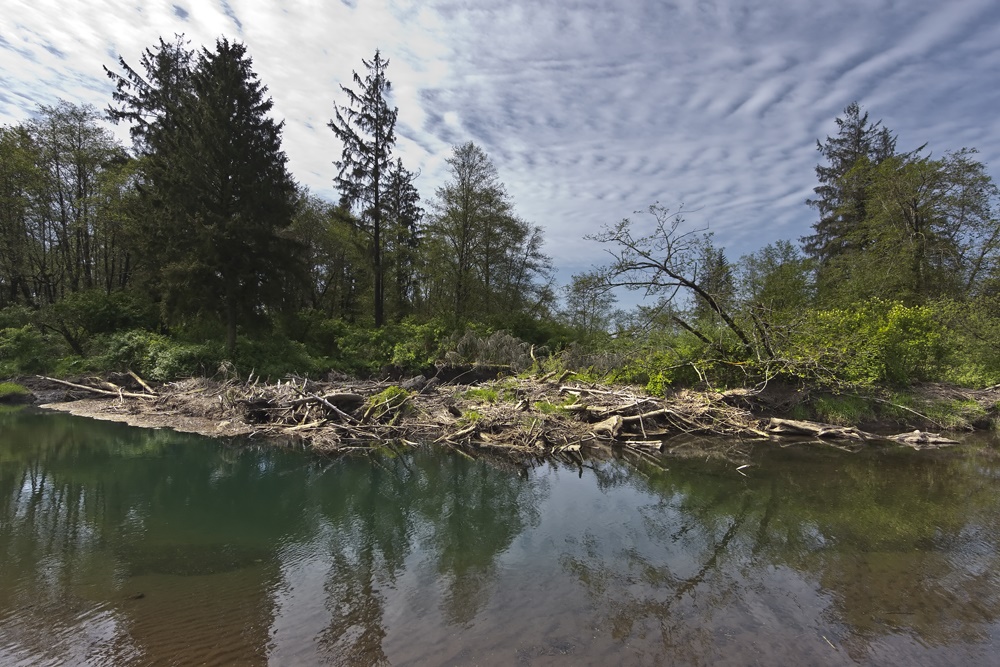
Restore freshwater and tidal connections, provide off-channel rearing habitat for salmonids, and restore historic spruce swamp habitat. A primary limiting factor for salmonids in the Kilchis system is the availability of off-channel habitat in low-lying areas, especially habitat in the saltwater-freshwater transition zone of the estuary (Kilchis Watershed Analysis, Tillamook Estuaries Partnership 1998). The site provides habitat for coho, Chinook and chum salmon, steelhead and cutthroat trout as well as a myriad of other wetland species, including colonial nesting waterbirds, migrating waterfowl, juvenile marine fishes and resident mammals. Human alterations of the estuary (e.g., dredging, diking, draining, filling, dairy pasture creation, jetty construction, sedimentation) as well as species loss have resulted in loss of habitats and their associated biotic communities. Current restoration is aimed at increasing protections for existing salmonid core areas, restoring tidal marsh habitat, re-creating tidal channels and restoring connectivity between tidal sloughs and the Kilchis River. Past restoration efforts have occurred above the project site and complement existing restoration efforts.
Purpose of the project:
Restore freshwater and tidal connections, provide off-channel rearing habitat for salmonids, and restore historic spruce swamp habitat. A primary limiting factor for salmonids in the Kilchis system is the availability of off-channel habitat in low-lying areas, especially habitat in the saltwater-freshwater transition zone of the estuary (Kilchis Watershed Analysis, Tillamook Estuaries Partnership 1998). The site provides habitat for coho, Chinook and chum salmon, steelhead and cutthroat trout as well as a myriad of other wetland species, including colonial nesting waterbirds, migrating waterfowl, juvenile marine fishes and resident mammals. Human alterations of the estuary (e.g., dredging, diking, draining, filling, dairy pasture creation, jetty construction, sedimentation) as well as species loss have resulted in loss of habitats and their associated biotic communities. Current restoration is aimed at increasing protections for existing salmonid core areas, restoring tidal marsh habitat, re-creating tidal channels and restoring connectivity between tidal sloughs and the Kilchis River. Past restoration efforts have occurred above the project site and complement existing restoration efforts.
Human Interest/Community Benefit:
Restored tidal marshes provide critical habitat for salmon and other species. Fish and wildlife provide direct community benefits through salmon fishing which is favored recreational use of Tillamook Bay and through wildlife viewing. Restored tidal marshes increase resiliency, which may help with flood mitigation.
The restored habitats will be accessible to the public and will create several miles of fishable habitat in the future. The Kilchis connects to the Tillamook County Water Trail.
Project Timeline:
Construction is slated to begin in summer 2015 for the Kilchis Estuary Preserve with re-vegetation occurring over the course of several subsequent years. Additional conservation efforts are planned for an adjacent estuary parcel beginning in 2016.
Partners:
Oregon Watershed Enhancement Board, The Nature Conservancy, Oregon Department of State Lands, USFWS Fish Passage Program, NFWF Governor’s Fund for the Environment, Portland General Electric Salmon Fund. Numerous other partners have been involved in restoration projects and activities throughout the Kilchis watershed.
